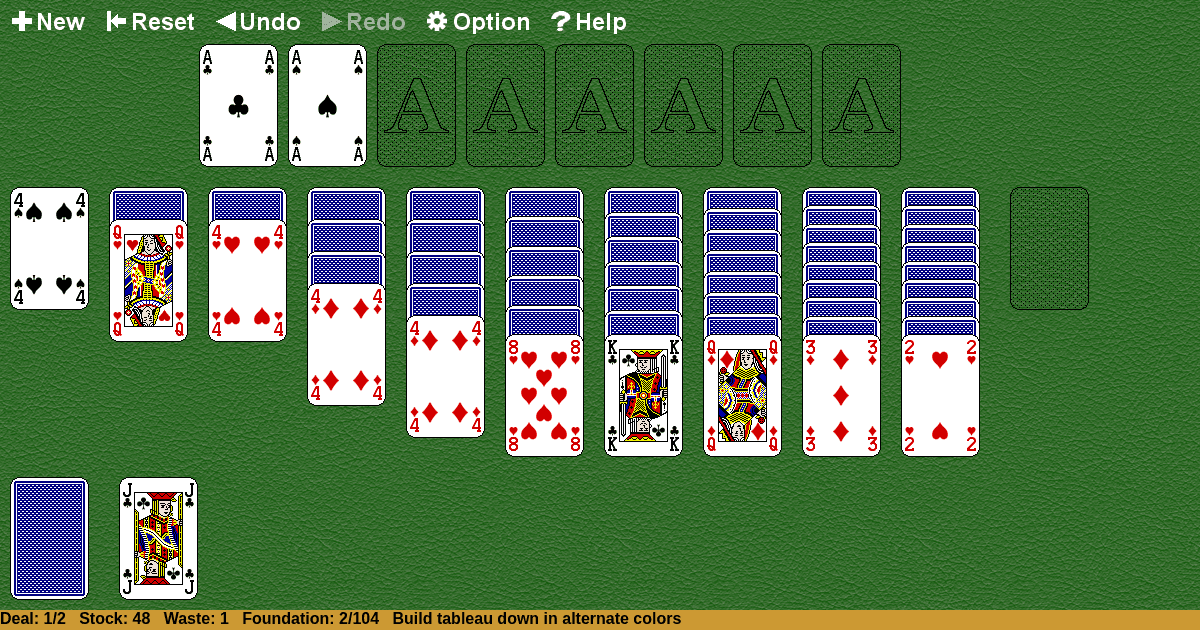Batsford Again
Home |
How to play |
FAQ |
About
How to play Batsford Again?
Game Objective:
The primary goal in Batsford Again Solitaire is to move all 104 cards (using two standard 52-card decks) to the eight foundation piles, building each foundation up in ascending order by suit from Ace to King.
Setup & Layout:
- Deck: Two standard 52-card decks (total 104 cards).
- Tableau: Ten tableau piles. The first pile receives one card, the second two cards, continuing up to the tenth pile with ten cards. Only the top card of each pile is dealt face-up; all other cards in the pile are face-down.
- Foundations: Eight foundation piles, all initially empty.
- Reserve: One reserve pile, initially empty. It can hold up to three cards.
- Stock: Remaining undealt cards form the stock pile, placed face-down.
- Waste: One waste pile, initially empty. Cards from the stock are dealt face-up to the waste.
Key Play Areas Defined:
- Tableau: The main area where cards are built down in alternating colors.
- Foundation: The target area where cards are built up by suit from Ace to King.
- Reserve: A holding area for up to three cards of the same rank, regardless of suit.
- Stock: The draw pile for new cards.
- Waste: Receives cards dealt from the stock; only the top card is available for play.
Batsford Again Solitaire Rules:
- Foundations: Build up by suit from Ace to King. Only Aces may be placed on empty foundations.
- Tableau: Build down by alternating color (red on black, black on red). Sequences of cards built down in alternating colors may be moved together as a group. Only Kings or sequences starting with a King may fill empty tableau spaces.
- Reserve: Build by equal rank, regardless of suit (e.g., any 5 can be placed on any other 5). Only the top card is available for play. The reserve may hold up to three cards. Only Kings may fill an empty reserve.
- Stock: When activated, deals one card face-up to the waste pile. Only one redeal is permitted, allowing for two complete passes through the stock.
- Waste: Only the top card is available for play. Once empty, it remains empty until more cards are dealt from the stock.
Gameplay:
Typical Sequence of Actions:
Move available Aces to empty foundation piles.
Build tableau piles down by alternating color, moving single cards or valid sequences.
Transfer cards to the reserve if they match the rank of the top card in the reserve (regardless of suit), up to three cards total.
Fill empty tableau spaces only with Kings or sequences starting with a King.
Draw cards from the stock to the waste pile; play the top waste card to the tableau, reserve, or foundation.
Move cards from the reserve to the tableau or foundation as allowed.
Introducing New Cards:
Cards enter play by drawing from the stock to the waste. Only the top waste card is playable.
No More Legal Moves:
If no legal moves are available and the stock is exhausted (including the permitted redeal), the game ends in a loss.
Winning & Losing Conditions:
- Winning: The game is won when all 104 cards are moved to the eight foundation piles, with each foundation built up by suit from Ace to King.
- Losing/Unwinnable State: The game is lost if no further legal moves are possible and the stock (including the single permitted redeal) is exhausted, leaving cards unplaced in the tableau, reserve, or waste.
Special Rules & Edge Cases:
Filling Empty Spaces:
Tableau: Only Kings or sequences headed by a King may fill empty tableau spaces.
Reserve: Only Kings may fill an empty reserve spot; up to three cards may be held in the reserve at any time.
Sequence Movement:
In the tableau, groups of cards built down in alternating color may be moved together as a unit.
Only the top card of the reserve or waste is available for play.
Redeal Limitation:
Only one redeal of the waste back into the stock is permitted, allowing for two complete passes through the stock.
Edge Cases:
If a tableau pile is emptied, it can only be filled by a King or a sequence headed by a King.
If the reserve is empty, only a King may be placed there.
If the waste is empty, it remains so until a new card is dealt from the stock.
Note: Batsford Again Solitaire is considered a difficult variant due to its double-deck setup, limited reserve, and restrictive redeal rule.




























































